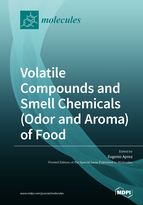Volatile Compounds and Smell Chemicals (Odor and Aroma) of Food
A special issue of Molecules (ISSN 1420-3049). This special issue belongs to the section "Analytical Chemistry".
Deadline for manuscript submissions: closed (31 March 2020) | Viewed by 83919
Special Issue Editor
Interests: gas chromatography; mass spectrometry; physical and chemical properties of food and relationship with human sensory perception; sensory analysis
Special Issues, Collections and Topics in MDPI journals
Special Issue Information
Dear Colleagues,
Among the constituents of food, volatile compounds are a particularly intriguing group of molecules, because they give rise to odour and aroma. Indeed, olfaction is one of the main aspects influencing the appreciation or dislike of particular food items. Volatile compounds are perceived through the smell sensory organs of the nasal cavity, and evoke numerous associations and emotions, even before the food is tasted. Such a reaction occurs because the information from these receptors is directed to the hippocampus and amygdala, the key regions of the brain involved in learning and memory.
In addition to identifying the odour active compounds, the analysis of the volatile compounds in food is also applicable for detecting the ripening, senescence, and decay in fruit and vegetables, as well as monitoring and controlling the changes during food processing and storage (i.e., preservation, fermentation, cooking, and packaging).
I warmly invite colleagues to submit their original research or review articles covering all aspects of volatile compounds research in the food sector (excluding pesticides), and/or the analytical methods used to identify, measure, and monitor these molecules.
Dr. Eugenio Aprea
Guest Editor
Manuscript Submission Information
Manuscripts should be submitted online at www.mdpi.com by registering and logging in to this website. Once you are registered, click here to go to the submission form. Manuscripts can be submitted until the deadline. All submissions that pass pre-check are peer-reviewed. Accepted papers will be published continuously in the journal (as soon as accepted) and will be listed together on the special issue website. Research articles, review articles as well as short communications are invited. For planned papers, a title and short abstract (about 100 words) can be sent to the Editorial Office for announcement on this website.
Submitted manuscripts should not have been published previously, nor be under consideration for publication elsewhere (except conference proceedings papers). All manuscripts are thoroughly refereed through a single-blind peer-review process. A guide for authors and other relevant information for submission of manuscripts is available on the Instructions for Authors page. Molecules is an international peer-reviewed open access semimonthly journal published by MDPI.
Please visit the Instructions for Authors page before submitting a manuscript. The Article Processing Charge (APC) for publication in this open access journal is 2700 CHF (Swiss Francs). Submitted papers should be well formatted and use good English. Authors may use MDPI's English editing service prior to publication or during author revisions.
Keywords
- Odour
- Aroma profiling
- Flavour
- Food processing
- Maillard reaction
- Oxidation
- Fermentation
- Food Decay
- Solid phase microextraction
- Gas chromatography
- Spectrometry
- Gas sensors
- Fingerprinting
- Volatilome







